Fun Upcycling Ideas & Projects
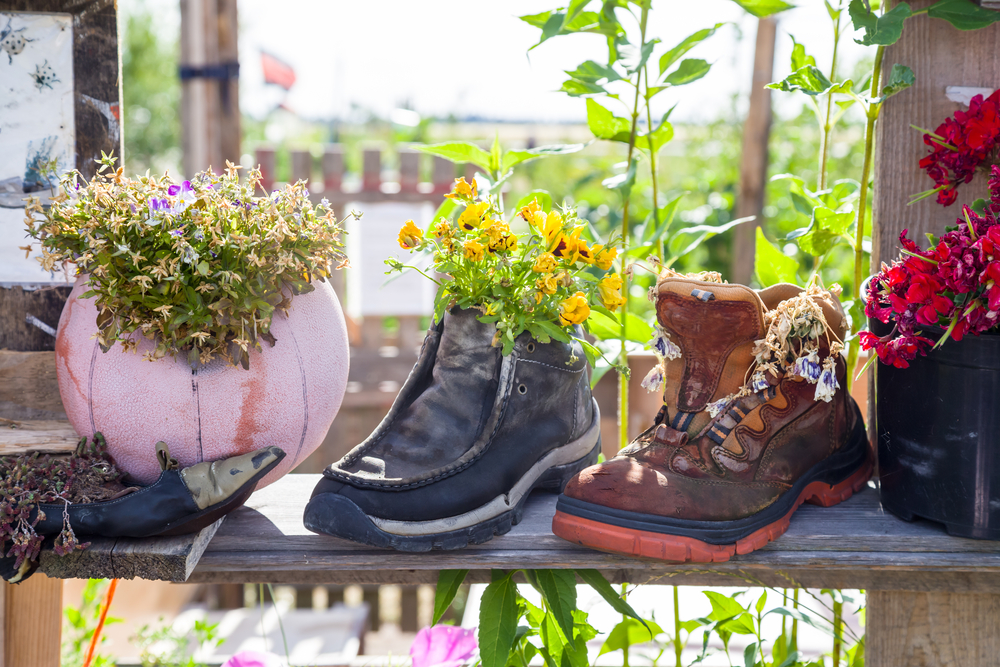
Repurposing, upcycling, recycling – whatever you want to call it, finding a new use for something that would otherwise end up in a landfill or dump is a great way to do your part to reduce waste in your community. There are hundreds, if not thousands, of websites devoted to this topic, each with its own perspective and view. Lowering the footprint we leave on this planet is something that has been a hot topic for the last 50 or more years.
Although until the mid-20th century most of the items people used that were not consumable (like food) were reused, the first recorded use of (commercially) recycled materials in the US was in 1690 in Philadelphia at the Rittenhouse Mill. This company used recycled rags made of linen and cotton to produce a paper that was sold to printers for use in the publishing industry. The next big push to reuse old items was during the Second World War.
The US government produced newsreels that were shown in movie theaters depicting all of the products that could be reused for the war effort. Similar campaigns took place in other allied countries. The next real push for recycling came about in the 1970s and has grown not only in popularity, but in the types of recycling programs that are available. From glass and paper to organic refuse collection, the types of waste that are collected vary in every area. Unfortunately, we have come to learn that recycling – like many other programs – has become a business, a BIG business, and the waste goes to the highest bidder or it sits on garbage barges around the world. In communities that have glass, paper and aluminum collections only a small percentage actually makes it to plants that process the materials for reuse.
So rather than recycling as the primary focus, the new thought is that each of us should work on reducing our use of disposable products and materials, as well as finding ways to repurpose them. Reduction is made more difficult by commercial use of over-packaging everything from fresh produce to just about anything you buy in a retail store. Choosing food products that are in bulk and can be purchased in paper sacks or reusable bags from home is one thing we can do to reduce the amount of packaging we personally are responsible for. This includes choosing loose fruit and vegetables rather than ones in bags.
The trend toward minimalism and tiny housing is definitely an offshoot of the idea of leaving a smaller footprint. Being consciously aware of each item that is owned and needs to take up space makes over-purchasing less likely. One rule many minimalists embrace is “Get one, give one”. Quite simply, for each new item purchased, a previously owned item must be given away to make room for the new item. Embracing this philosophy makes a person think about every purchase.
Repurposing what would have been waste is another way to leave a smaller footprint. Reusing everything from jars to old furniture can create an abundance of interesting things that can be put to use in one’s own home or be sold for additional income. The projects listed below range from simple kid-friendly ideas to more complex undertakings that require varying levels of skill and equipment. Use the ideas listed for inspiration and have fun creating your own ways to upcycle and repurpose the things you thought were headed to the garbage dump.
Plastic Bottles Repurposed:
Try as we may it is really hard to never use a disposable plastic bottle. They are everywhere from vending machines and convenience stores to sporting and other events. In today’s germ-phobic world using a public water fountain is often seen as being unhygienic, and unfortunately it isn’t always possible to find a water bottle refilling station. What can be done with all of these bottles? Tons!
Plastic Bottle Green Wall
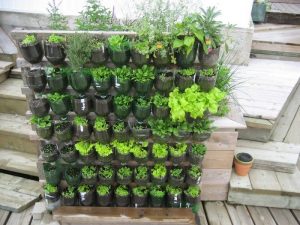 Cut the bottles so that the top ⅓ is separated from the bottom and can be inverted into the bottom ⅔. The bottom section will be used to collect water and the top will have potting soil or another organic planting medium added so a leafy green plant can grow there. You can use as many bottles as you would like, but the more you use the greater the effect and final look. Using hot glue, attach the inverted top ⅓ to the bottom part. Once attached on one side, drill a hole. Use this hole to place a screw through and attach the bottle either directly to the surface you plan on covering or to a wooden frame to place over the wall. The bottles should be placed close together so once the plants begin to grow and mature the bottles are no longer visible. If you plant edible greens you will have a great source of fresh greens daily or you could plant more decorative plants. Check out these two videos (1,2) to see how we combined the ideas via their detailed instructions.
Cut the bottles so that the top ⅓ is separated from the bottom and can be inverted into the bottom ⅔. The bottom section will be used to collect water and the top will have potting soil or another organic planting medium added so a leafy green plant can grow there. You can use as many bottles as you would like, but the more you use the greater the effect and final look. Using hot glue, attach the inverted top ⅓ to the bottom part. Once attached on one side, drill a hole. Use this hole to place a screw through and attach the bottle either directly to the surface you plan on covering or to a wooden frame to place over the wall. The bottles should be placed close together so once the plants begin to grow and mature the bottles are no longer visible. If you plant edible greens you will have a great source of fresh greens daily or you could plant more decorative plants. Check out these two videos (1,2) to see how we combined the ideas via their detailed instructions.
Plastic Bottle Sprinkler
 Cut the bottles so that the top ⅓ is separated from the bottom and can be inverted into the bottom ⅔. The bottom section will be used to collect water and the top will have potting soil or another organic planting medium added so a leafy green plant can grow there. You can use as many bottles as you would like, but the more you use the greater the effect and final look. Using hot glue, attach the inverted top ⅓ to the bottom part. Once attached on one side, drill a hole. Use this hole to place a screw through and attach the bottle either directly to the surface you plan on covering or to a wooden frame to place over the wall. The bottles should be placed close together so once the plants begin to grow and mature the bottles are no longer visible. If you plant edible greens you will have a great source of fresh greens daily or you could plant more decorative plants. Check out these two videos (1,2) to see how we combined the ideas via their detailed instructions.
Cut the bottles so that the top ⅓ is separated from the bottom and can be inverted into the bottom ⅔. The bottom section will be used to collect water and the top will have potting soil or another organic planting medium added so a leafy green plant can grow there. You can use as many bottles as you would like, but the more you use the greater the effect and final look. Using hot glue, attach the inverted top ⅓ to the bottom part. Once attached on one side, drill a hole. Use this hole to place a screw through and attach the bottle either directly to the surface you plan on covering or to a wooden frame to place over the wall. The bottles should be placed close together so once the plants begin to grow and mature the bottles are no longer visible. If you plant edible greens you will have a great source of fresh greens daily or you could plant more decorative plants. Check out these two videos (1,2) to see how we combined the ideas via their detailed instructions.
Plastic Bottle Scoops
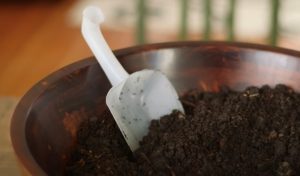 Laundry detergent bottles, milk jugs and all heavyweight plastic jugs can be turned into scoops for the sandbox or to use around the house. You can mark off and cut your bottles in any way that you prefer, creating many different types of scoops. Here is a simple tutorial.
Laundry detergent bottles, milk jugs and all heavyweight plastic jugs can be turned into scoops for the sandbox or to use around the house. You can mark off and cut your bottles in any way that you prefer, creating many different types of scoops. Here is a simple tutorial.
Glass Bottles Repurposed:
Glass bottles have a permanence that plastic does not. They come in unique and varied shapes and colors. Before repurposing, remove the glued-on labels with a little warm water or some adhesive solvent. Clean the bottles with soapy water or a vinegar and water solution. Now you are ready to get creative!
Dry Goods Storage
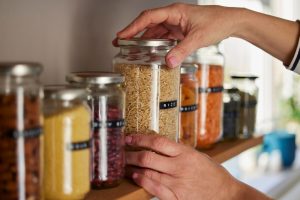 One of the simplest repurposing uses of glass bottles is to store something other than what originally came in them. Grains, spices, seeds, office supplies, etc. Anything that can benefit from being stored in a sealed glass container or as a way to organize art and craft supplies. No special tools are needed for this upcycling project.
One of the simplest repurposing uses of glass bottles is to store something other than what originally came in them. Grains, spices, seeds, office supplies, etc. Anything that can benefit from being stored in a sealed glass container or as a way to organize art and craft supplies. No special tools are needed for this upcycling project.
Wine Bottle Candle Hurricane Chimneys
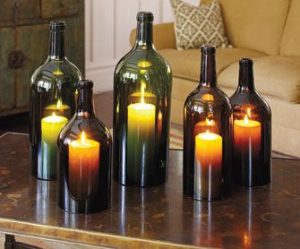 Using old wine bottles to create a hurricane chimney for a decorative candle can be stunning and can create ambiance in an otherwise dull area of your home or patio. To make these you will need some equipment that should be easily accessible in a hardware or craft store. You will need: a glass bottle cutting tool (these range in price, starting at about $10 and going up into the hundreds), safety goggles, sandpaper and gloves that will protect your hands from glass splinters and cuts. Just follow the instructions that come with your bottle cutter to cut the bottom off of a clean wine bottle and after you have smoothed the cut edge with sandpaper you have a beautiful hurricane chimney to place over a candle.
Using old wine bottles to create a hurricane chimney for a decorative candle can be stunning and can create ambiance in an otherwise dull area of your home or patio. To make these you will need some equipment that should be easily accessible in a hardware or craft store. You will need: a glass bottle cutting tool (these range in price, starting at about $10 and going up into the hundreds), safety goggles, sandpaper and gloves that will protect your hands from glass splinters and cuts. Just follow the instructions that come with your bottle cutter to cut the bottom off of a clean wine bottle and after you have smoothed the cut edge with sandpaper you have a beautiful hurricane chimney to place over a candle.
Glass Bottle Bottom Concrete Pavers
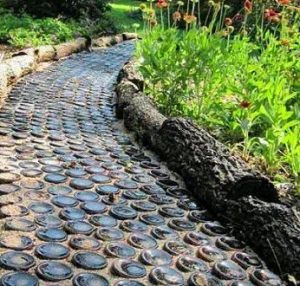 This is the perfect use for the bottoms of the bottles you have cut to make hurricane chimneys. Using a mold for concrete pour a layer of concrete and then press the bottle bottoms into the wet concrete. They should fill as you press them down and will make decorative trivets or pavers for a pathway. Some beautiful examples of pavers and other designs using glass bottles can be found on the blog Dishfunctional Designs.
This is the perfect use for the bottoms of the bottles you have cut to make hurricane chimneys. Using a mold for concrete pour a layer of concrete and then press the bottle bottoms into the wet concrete. They should fill as you press them down and will make decorative trivets or pavers for a pathway. Some beautiful examples of pavers and other designs using glass bottles can be found on the blog Dishfunctional Designs.
Old Furniture, New Function:
Taking an old chair or an old chest of drawers and giving it new life and a different purpose is a great way to upcycle something that would otherwise be discarded. If you are lucky you may find treasure on the curbside in someone’s trash – be polite and ask before taking, however.
Dining Room Chair to Bench
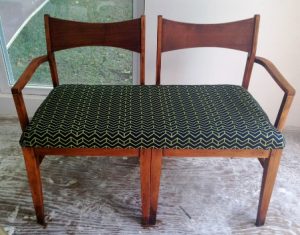 An ingenious and cute project is to turn two matching or mismatched wooden chairs into a cute bench. Diycrafts has a bunch of really great ideas and instructions for upcycling old wooden chairs.
An ingenious and cute project is to turn two matching or mismatched wooden chairs into a cute bench. Diycrafts has a bunch of really great ideas and instructions for upcycling old wooden chairs.
Old Dresser into a TV/Entertainment Console
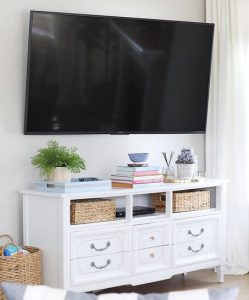 This is an amazing way to turn that ugly old dresser from your childhood into a chic updated piece of furniture. The instructions given here are easy to follow and can be done by a newbie to upcycling. Put on an old work shirt and get ready to use some elbow grease and craftsmanship.
This is an amazing way to turn that ugly old dresser from your childhood into a chic updated piece of furniture. The instructions given here are easy to follow and can be done by a newbie to upcycling. Put on an old work shirt and get ready to use some elbow grease and craftsmanship.
Old Crib to Kid’s Craft Table/Desk
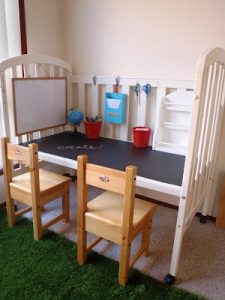 Once your child outgrows the crib of course you could always donate it or gift it to a friend, but you could also create an adorable and multifunctioning desk for your toddler or young child to use for years. It is a simple project. First, remove the drop side of the crib. Next, adjust to base (the part that holds the mattress) to the highest newborn setting. Cut two sheets of thick mdf to fit snugly into the mattress base to provide a table top. Finally, paint the boards. You can paint them to match the rest of the desk, or use chalkboard paint for a fun chalkboard surface. There are many different websites with different examples and YouTube videos on this project. Here is a really cute example from A Little Learning for Two.
Once your child outgrows the crib of course you could always donate it or gift it to a friend, but you could also create an adorable and multifunctioning desk for your toddler or young child to use for years. It is a simple project. First, remove the drop side of the crib. Next, adjust to base (the part that holds the mattress) to the highest newborn setting. Cut two sheets of thick mdf to fit snugly into the mattress base to provide a table top. Finally, paint the boards. You can paint them to match the rest of the desk, or use chalkboard paint for a fun chalkboard surface. There are many different websites with different examples and YouTube videos on this project. Here is a really cute example from A Little Learning for Two.
Related Articles
Related
Help! I’m Bored
Ouch, I walked into the open closet door. The green and yellow Sprite bottle was sticking out of the bulging recycling bag. How many times must I ask my children to return the bottles? It’s summer, it’s raining, and the pool is closed. My three children are looking at...
7 Makeup Brands That Are Cruelty-Free
High-End, Luxury, Moderate, Vegan Options, New on Market. Concerned consumers are looking beyond the familiar brands of yesterday. Here’s why. Kindness and compassion may be trending today, but they’ve always been core values in Judaism. Although other humans...
Save Money and the Planet with 4 Simple Ingredients
Your kids or Instagram or your own conscience and diminishing bank account are telling you that there must be a better way to clean the house than using expensive, corrosive, dangerous chemicals. Where do you start to make the changes you know you want to make? We...
